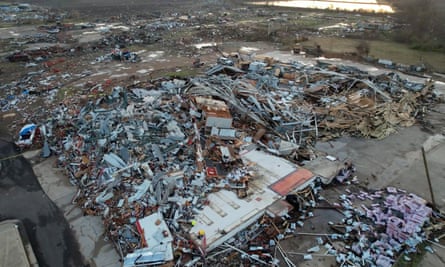Devastating storms and at least one large tornado which ripped through rural Mississippi on Friday night left 25 people dead in the state, dozens injured and rescue workers hauling people from rubble throughout Saturday, as the state reeled from its highest tornado-related death toll in decades.
Severe weather pounded several southern states overnight as the centers of destruction emerged on Saturday morning as the small, majority Black towns of Rolling Fork and Silver City in the Mississippi delta.
As the sheer scale of devastation was revealed, Rolling Fork’s mayor Eldridge Walker declared: “My city is gone.”
Speaking to CNN as images circulated of entire neighborhoods flattened to rubble, cars crumpled, and trees shorn of their leaves, Walker continued: “But we are resilient and we are going to come back strong.”
He added: “Families are affected, homes are torn up, families are without a place to live, children are hungry this morning, no clothes.”
Rolling Fork has a population of about 2,000 people, with approximately 20% of residents living below the poverty line and 21% living in mobile homes, making them especially vulnerable to extreme weather. The town is known as the birthplace of the Blues music pioneer Muddy Waters.
Officials in north central Alabama, reported that one man died after his trailer home overturned in the storms, bringing the total death toll from the night’s extreme weather to 26.
Disaster response officials in Mississippi said on Saturday afternoon that deaths were recorded in four counties throughout the state, three in the delta region and one at Mississippi’s northern border with Alabama.
The National Weather service was dispatching teams to locations throughout the delta region to assess damage as state responders scrambled to reach affected areas on Saturday morning. The agency sought to determine whether a path of destruction stretching over 100 miles across the state was caused by a single tornado or multiple cyclones that touched down throughout the night.
“The loss will be felt in these towns forever,” Mississippi’s governor, Tate Reeves, tweeted as he headed to Rolling Fork on Saturday morning. “Please pray for God’s hand to be over all who lost family and friends.”
The federal disaster agency Fema was also dispatching a team to assist state responders, and Reeves announced he had sought disaster assistance from the US government after declaring a state of emergency in all counties affected by the extreme weather.
Joe Biden later expressed condolences on Twitter. The president also offered “full federal support as communities recover from the effects of this storm”.
Severe storms swept through parts of Tennessee and Alabama as well, leaving about 60,000 people in the region without power on Saturday morning, according to the tracking site poweroutage.us.
“There’s nothing left,” said Wonder Bolden, speaking to the Associated Press while standing outside the remnants of her mother’s now-leveled mobile home in Rolling Fork. “There’s just the breeze that’s running, going through – just nothing.”
Sheddrick Bell, his partner and two daughters told the AP they had crouched in a closet of their Rolling Fork home for 15min as the tornado barreled through. His daughters wouldn’t stop crying. He could hear his partner praying out loud beside him.
According to records maintained by the National Weather service, the tornado’s death toll will now rank as the highest in Mississippi in the 21st century and the worst in over 50 years. This weekend’s catastrophe has now surpassed an outbreak of tornados in April 2011, which killed dozens throughout the south-eastern US region, including 23 in Mississippi.
The storm system was a supercell, the kind that brew the deadliest tornadoes and most damaging hail in the United States, said Walker Ashley, a meteorology professor at the University of Northern Illinois speaking to the Associated Press.
Meteorologists had seen a big tornado risk coming for the general region as much as a week in advance, said Ashley, who was discussing it with his colleagues as early as 17 March. The National Weather Service’s storm prediction center put out a long-range alert for the area on 19 March, he said.

Tornado experts have been warning about increased risk exposure in the region because people there are building more. “You mix a particularly socioeconomically vulnerable landscape with a fast-moving, long-track nocturnal tornado and disaster will happen,” Ashley said in an email.
Matt Elliott, a warning coordination meteorologist at the National Oceanic and Atmospheric Administration’s storm prediction centre in Norman, Oklahoma said the severe weather was expected across several states.
More severe storms are expected for the region on Sunday, with a level two out of five risk of damaging winds, isolated tornadoes, and severe hail. The areas impacted will include Montgomery, Alabama; Jackson, Mississippi; and Columbus and Macon in Georgia.
With an additional 2in to 4in of rain predicted through Sunday, flooding is also possible, meteorologists said.
Edward Helmore and the Associated Press contributed reporting

